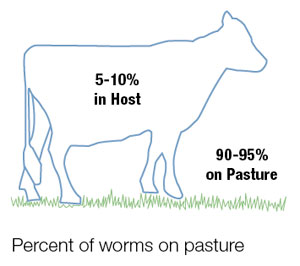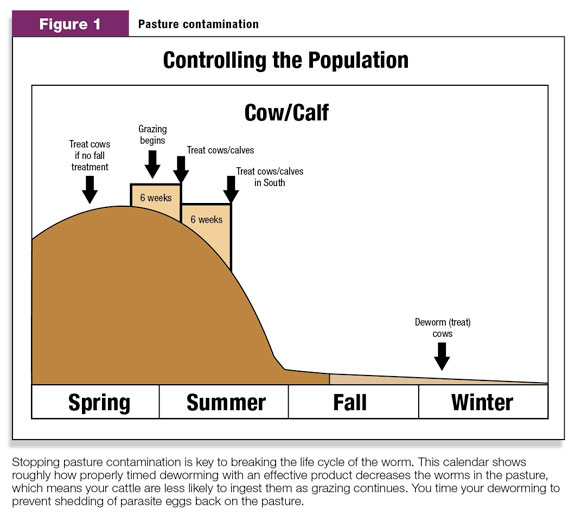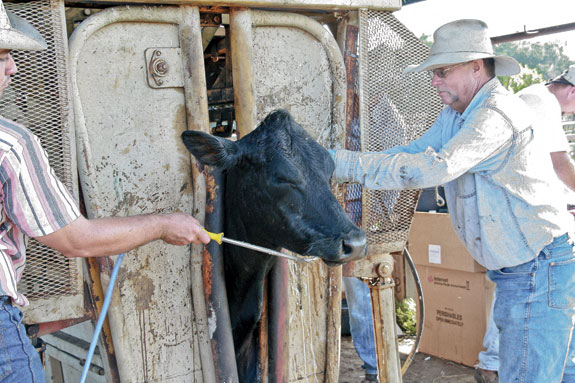including cow/calf, stocker and feeding operations.
And unfortunately, parasite infections have a costly result on cattle health and performance, including reproductive losses, hampered immune responses, reduced appetite and lower weight gain.
A recent Iowa State University study showed this can negatively impact the productivity of a calf to the tune of $190 throughout its lifetime.
Parasites in young and growing animals are much more detrimental than they are in older animals, so it’s vitally important to keep parasites in check for calves, replacement heifers, stockers and feeder cattle.
But all cattle can host internal parasites, so a whole-herd deworming program is beneficial. While it’s true the adult cow will develop some immunity to major internal parasites, she still sheds a tremendous number of eggs that are a major source of infection for calves.

Deworm the pasture
Parasitologists have found that only 1 to 5 percent of worms are actually in the cow herd. Most are in the form of eggs and larvae on the pasture.
So it is here that producers must think strategically to reduce the parasite population and prevent losses.
When you consider a strategic deworming program, what you’re really trying to do is reduce the parasite burden on the pasture for as much of the grazing season as possible.
When the pasture is at its best, the environment for parasite transmission is ideal. Therefore, you should attack the worms when the pasture is growing rapidly.
Deworming at this strategic time will have the most impact by decreasing the number of eggs and larvae on the pasture – and worms in the animal.
On cow-calf and stocker operations, grazing animals are exposed to parasite larvae on a daily basis via the grass they consume.

Most parasites have the same basic life cycle; however, they do not all appear at the same time of year, and weather can play a major role in the number of larvae that are able to survive and infect the animal.
Warm wet weather, for example, is an ideal condition for parasites on pasture, while dry, hot weather is not.
Strategic deworming calls for a basic understanding of the life cycle of parasites that normally infect the animal and an awareness of when they are present in the highest numbers on pasture.
These conditions make designing a blanket strategic deworming program to fit every producer impossible.
Therefore, cattle producers should consult with their veterinarian or a parasitologist to help design a strategic deworming program for their operation.
Those variables aside, a basic strategic deworming program for the cow-calf producer may resemble the following:
- Deworm cows and calves 6 to 8 weeks after turning your animals on grass in the spring.
- In the South, deworm again 6 to 8 weeks later, depending on weather conditions.
- Deworm your animals again in the fall after a killing frost occurs and cooler temperatures prevail.
Timing of cattle deworming is important but not always convenient. Deworming your animals can be accomplished with a chute-side treatment.
All too often, the ideal time to deworm your cattle does not overlap with the best time for working your herd.
Fortunately, with non-handling dewormers producers can actually treat their animals at the ideal time without having to handle the cattle.
Plus, studies show it can cost up to $5 per head to handle and work your cattle, so there are economic as well as physical advantages to non-handling forms of treatment.
Dewormers are available in several non-handling forms and can be fed to cattle in the form of minerals, range cubes, protein blocks or liquid feed.

Is your dewormer working?
Timing and method of administration are just part of the deworming equation. What producers really need to know next is if their dewormer is working.
A growing body of research data indicates that avermectins are not as efficacious as they once were.
Some studies are indicating that Cooperia are the main parasite left behind after treatment with avermectin compounds, which is indicative of tolerance or resistance to these dewormers.
(Cooperia are especially detrimental to animals under 24 months old.) Some research studies are even showing reduced efficacy of the avermectin compounds to Ostertagia (the brown stomach worm) as well.
A useful tool for determining if your dewormer is still effective is the fecal egg count reduction test (FECRT).
Leading cattle parasitologists from around the United States, in conjunction with Intervet/Schering-Plough Animal Health, developed a standardized protocol for the FECRT.
The protocol provides results that can be used to determine the efficacy of a given deworming protocol.
The FECRT is based on the fact that treatment with a dewormer should kill worms in an animal, eliminating the production and shedding of eggs.
You should expect to have at least a 90 percent reduction in the average number of eggs post-treatment.
If there’s less than a 90 percent reduction in egg shedding, the producer needs to go back and look at certain variables such as, “was the product used correctly, dosed correctly and applied properly?”
If all of these can be answered “yes,” then there is reason to be concerned about possible resistance problems and the producer should contact his veterinarian or parasitologist for further investigation.
The FECRT protocol is fairly simple for a producer to follow. Basically, the producer takes 20 fresh or observed dropping samples on the day he deworms his cattle, then repeats the sampling 14 days later.
The animals should be in the same herd or management group, but do not have to be the same animals. They should also be in the same age group.
The producer also needs to request the lab use a Modified Wisconsin sugar float or Double Wisconsin sugar float procedure. A copy of this protocol may be obtained by calling Intervet/Schering-Plough Animal Health at 1-800-211-3573.
A solid foundation
A good parasite control program provides the foundation to nearly all other health and production management practices.
That’s why it’s vitally important to make sure you deworm your animals at the optimum time to have the greatest impact on the parasites in the animal as well as on the pasture.
Then work with your veterinarian or animal-health provider to ensure the product you are using is working by doing a fecal egg count reduction test. ![]()
PHOTOS
TOP: Dewormers are available in several non-handling forms, and can be fed to cattle in the form of range cubes.
BOTTOM: Optimal times to deworm cattle, such as with this type of drench, are usually in spring before turning animals onto grass, and again in fall. Photos courtesy of Intervet/Schering-Plough Animal Health.

Harold Newcomb
Technical Services Veterinarian
Intervet/Schering-Plough Animal Health
harold.newcomb@sp.intervet.com







